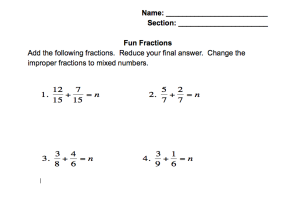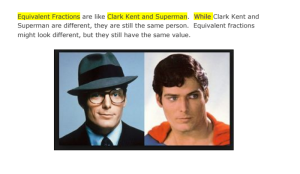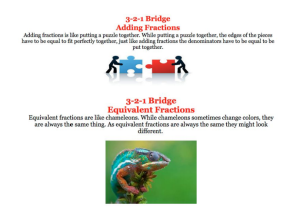Unit Goal
The learner will understand how to add fractions as well as mixed numbers with unlike denominators.
Unit Objectives
Background and Rationale
Learning how to add fractions helps with building a great foundation and helps to develop more confidence as students advance in math and science classes. This lesson will lead to the next lesson on how to subtract fractions. Fractions are in everyday life construction, recipes, landscaping, are just a few things were fractions show up.
In this lesson the student will learn about how to add fractions with unlike denominators. Additionally, the student will review adding fractions with like denominators, equivalent fractions, improper fractions, mixed numbers, prime numbers, and LCM. The student will have access to lessons that have been taught online, and there will be extra problems provided for students that need more practice, the steps for the process will be given to them in their notes, Anchor Charts, collaboration, conferencing with students and teacher, and the students will be reflected throughout the unit.
At the end of the unit, along with a test, the students will create a 3-2-1 Bridge about adding fractions with unlike denominators. This will help to determine if there is an understanding of what they are doing and why.
Bloom’s Taxonomy
Creating (highest level)
Common Core / State and District Standards
Learning and Innovation Skills (P21.org)
Creativity and innovation
Think Creatively:
-
Use a wide range of idea creation techniques (such as brainstorming)
-
Create new and worthwhile ideas (both incremental and radical concepts)
-
Elaborate, refine, analyze and evaluate their own ideas in order to improve and maximize creative efforts
Work Creatively with Others:
-
Develop, implement and communicate new ideas to others effectively
-
Be open and responsive to new and diverse perspectives; incorporate group input and feedback into the work
Reason Effectively:
-
Analyze how parts of a whole interact with each other to produce overall outcomes in complex systems
Make Judgments and Decisions
-
Effectively analyze and evaluate evidence, arguments, claims and beliefs
-
Analyze and evaluate major alternative points of view
-
Reflect critically on learning experiences and processes
Communicate Clearly
-
Articulate thoughts and ideas effectively using oral, written and nonverbal communication skills in a variety of forms and contexts
Collaborate with Others
-
Demonstrate ability to work effectively and respectfully with diverse teams
Life and Career Skills (P21.org)
Flexibility and Adaptability: Be Flexible
-
Incorporate feedback effectively
-
Deal positively with praise, setbacks and criticism
Initiative and Self Direction: Work Independently
-
Monitor, define, prioritize and complete tasks without direct oversight
Productivity and Accountability: Produce Results
-
Multi-task
-
Participate actively, as well as be reliable and punctual
-
Present oneself professionally and with proper etiquette
-
Collaborate and cooperate effectively with teams
-
Respect and appreciate team diversity
-
Be accountable for results
Information, Media, and Technology Skills (P21.org)
Create Media Products
-
Understand and utilize the most appropriate media creation tools, characteristics and conventions
Apply Technology Effectively
-
Use technology as a tool to research, organize, evaluate and communicate information
-
Use digital technologies (computers, PDAs, media players, GPS, etc.), communication/networking tools and social networks appropriately to access, manage, integrate, evaluate and create information to successfully function in a knowledge economy
Lesson – Introduction
Post the question on the day. This is done to allow the students to evaluate themselves each day after they have practiced with specific skills as well as received feedback frrom peers and the teacher. This will help the students to have an understanding of where they are with their learning and be able to see their own progress. This also allows them to take ownership of their own learning process.
Lesson Activities and Procedures
Day one will consist of 30 minutes for practice.
Day two will consist of collaboration with peers and/or the teacher which will be 60 minutes. The student will also be required to work the few new practice problems that are customized to what the student is having trouble with. They will then be required to take a *checking-in (Some students that get a 100 on their *checking in will not be required to work extra problems.) All students will need to watch the teacher-made tutorials of the lesson and take notes on mean, median, and mode.
Day three will consist of the learner watching another teacher-made tutorial and taking notes on the material. They will practice what they have learned through collaboration with their peers and teacher.
Day four will consist of collaboration with peers and/or the teacher which will be 60 minutes. The student will also be required to work the few new practice problems that are customized to what the student is having trouble with. They will then be required to take a *checking-in (Some students that get a 100 on their *checking in will not be required to work extra problems.) All students will need to watch the teacher-made tutorials of the lesson and take notes on mean, median, and mode.
Day Five will consist of the students applying the thinking routine
Student Procedure |
Teacher Procedure |
Materials |
|---|---|---|
| Day 1 | Day 1 | Day 1 |
| The student will watch a techer-made lesson created by their teacher on adding fractions with unlike denominators, Or the students can watch the teacher demonstrate how to add fractions using the steps during fact-to-face instruction. (5 min) | The teacher will provide 3 Simple Steps for Adding Fractions.Step 1:
Step 2: Add the numerators keeping the denominator the same. Step 3: You need to simplify your fraction if needed. You might need to change an improper fraction to a mixed number. This will give you your final answer. |
Teacher-made tutorials
Screencast: teacher-made video for delivering instruction at home for flipped teaching (5 min) |
|
The student will take notes and work some practice problems while watching the lesson. |
The teacher will provide practice problems for the students to work. |
practice problems from AAA math or from IXL (see above links) |
| Day 2 | Day 2 | Day 2 |
|
The student will come in the next day and take a “checking-in” so the teacher and student can see where they are on their understanding of the concept. |
The teacher will give a few practice problems either on a sheet of paper or within a technology tool (Quia.com) or Learning Management System (Haiku.com) |
Learning Management System (LMS): Google, Edmodo, and/or Haiku for online learning |
|
The student will then reflect on the problems they got wrong by doing the following: a. They will go over the steps making sure they followed each step. b. Collaborate with a peer to talk about how to work the problems. c. They will meet with the teacher in small groups.
Differentiation: Have students that are having trouble with the concept to draw pictures of what they think the fraction addition problem will look like. You can check for understanding with this activity. As a teacher you can also have drawings on hand to help those that learn better with visuals. |
The teacher will have the students to recall the steps for adding fractions in small groups or one-on-one with the teacher. The teacher will provide differentiation through drawings for the visual learners. |
|
| After making corrections and reflecting the student will work another practice problem following the steps. | The teacher will instruct the students who need more practice to complete additional problems. | customized list |
| Day 3 | Day 3 | Day 3 |
| The student will watch a teacher-made tutorial on adding mixed fractions with unlike denominators and adding whole numbers to fractions, or the students can watch the teacher demonstrate this on the board. |
The teacher will provide the steps for adding mixed fractions with unlike denominators and adding whole numbers to fractions. | Teacher-made tutorialsScreencast: teacher-made video for delivering instruction at home for flipped teaching (5 min)see link above |
| The student will take notes and work some practice problems while watching the lesson. | The teacher will provide practice problems for the students to work. | |
| Day 4 | Day 4 | Day 4 |
| The student will come in the next day and take a “checking in” so the teacher and student can see where they are on their understanding of the concept. | The teacher will give a few practice problems either on a sheet of paper or within a technology tool | Learning Management System (LMS): Google, Edmodo, and/or Haiku for online learning |
|
The student will then reflect on the problems they got wrong by doing the following: a. They will go over the steps making sure they followed each step. b. Collaborate with a peer to talk about how to work the problems. c. They will meet with the teacher in small groups.
Differentiation: Have students that are having trouble with the concept to draw pictures of what they think the fraction addition problem will look like. You can check for understanding with this activity. As a teacher you can also have drawings on hand to help those that learn better with visuals. |
The teacher will have the students to recall the steps for adding fractions in small groups or one-on-one with the teacher.The teacher will provide differentiation through drawings for the visual learners. | Customized list |
| Day 5 | Day 5 | Day 5 |
| The student will work on their 3-2-1 with a partner and collaborate on what they are going to compare the concept to. | The teacher will organize groups for completing a 3-2-1 Bridge using fractions and explain how to apply the thinking routine. | Making Thinking Visible |
| The student will present their final 3-2-1 to the class in a Google Doc. | The teacher will give feedback to the students. When they have a final product the student can find a picture that will work | 3-2-1 bridge |
Lesson Closure
Show the students a 3-2-1 bridge thinking routine. Let them know that they will create one since they have learned about fractions within this lesson. Students will create and share the final product of their 3-2-1 Bridge with the class on a Google Doc; some will present to the class, and others will display their work in the classroom. The students will also take a test on the concept.
Example:
Assessment

The 3-2-1 Bridges are assessed for creativity and understanding of the concept well enough to pick an “out-of-the-box” concept to compare to adding fractions. When they present the 3-2-1 Bridge are they able to explain why they wrote what they wrote.
Teacher Reflection
References: Puzzle image source: http://imgkid.com/2-puzzle-piece-image.shtml Superman image source: http://www.toptenz.net/top-10-alter-egos.php Chameleon image source: http://www.lizardtypes.com/chameleon-pictures/




